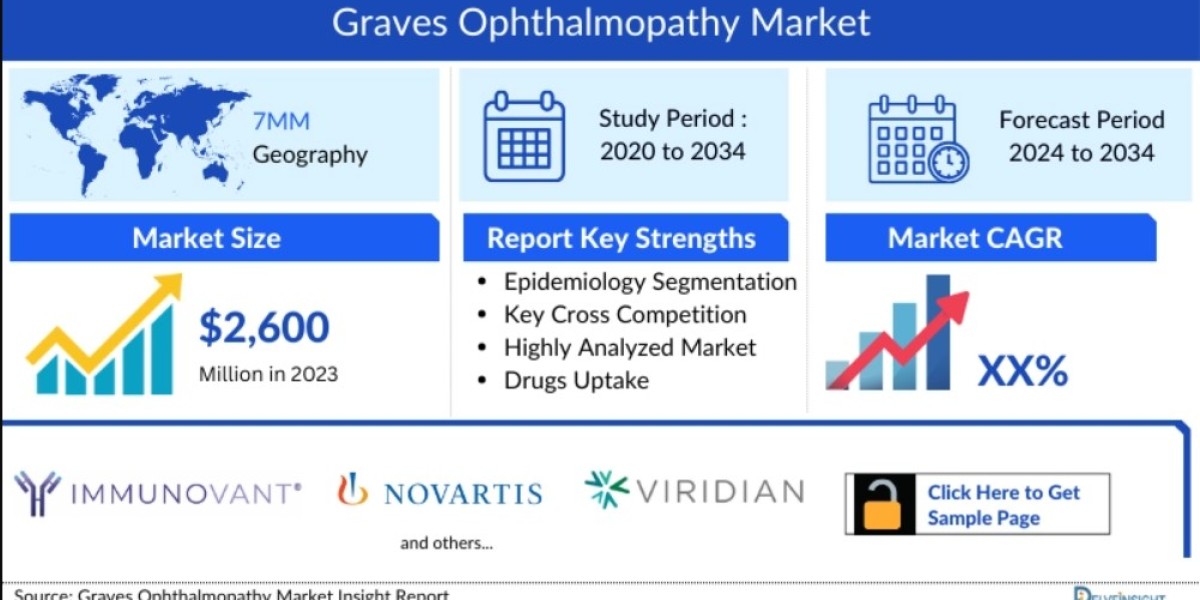Market Insight
The Graves’ ophthalmopathy market has seen significant developments in recent years, with the advent of targeted therapies addressing the underlying immune mechanisms of the disease. Traditional treatment options, such as corticosteroids and orbital decompression surgery, focus on symptom management but have limitations in efficacy and safety. The introduction of biological therapies, particularly teprotumumab (approved in 2020), has revolutionized the treatment landscape by directly targeting insulin-like growth factor-1 receptor (IGF-1R), a key driver in TED pathogenesis.
Market growth is driven by increasing awareness of Graves’ ophthalmopathy, advances in diagnostics, and a rising prevalence of autoimmune disorders globally. The expansion of therapeutic options and ongoing research into novel biologics are expected to propel market growth further. Additionally, efforts to develop therapies for mild to moderate TED patients and improve long-term outcomes are broadening the market’s scope.
Epidemiology Overview
Graves’ ophthalmopathy affects approximately 25-50% of patients with Graves’ disease. The global prevalence of Graves’ disease is estimated to be around 1-2% of the population, with higher rates observed in women than men. TED predominantly affects individuals between the ages of 40 and 60 years and is more severe in smokers and those with poorly managed thyroid disease.
The rising prevalence of autoimmune thyroid disorders, coupled with an aging population and increased environmental triggers, is expected to lead to a steady rise in TED cases. Improved diagnostic measures and screening for early-stage disease are also contributing to higher detection rates, further expanding the target population for treatment.
Market Forecast – 2034
The Graves’ ophthalmopathy market is projected to grow significantly through 2034, driven by:
Expansion of Biologic Therapies: The increasing adoption of teprotumumab and ongoing clinical trials for novel biologics will enhance treatment options.
Increased Awareness: Educational initiatives and improved diagnosis will bring more patients into the treatment ecosystem.
R&D Investment: Significant investment in research to target mild to moderate TED cases and improve safety profiles will sustain market growth.
By 2034, the global market for Graves’ ophthalmopathy is anticipated to reach multi-billion-dollar valuations, offering hope for improved patient outcomes and quality of life.
Conclusion
The Graves’ ophthalmopathy market is evolving rapidly, with biologics leading the charge in transforming treatment paradigms. With ongoing advancements, a deeper understanding of TED epidemiology, and the development of innovative therapies, the market is well-positioned for robust growth over the next decade.
Latest Reports
chemotherapy induced neutropenia market | circadian rhythm disorders market | dermal regeneration matrix market | trauma fixation devices market | vaso-occlusive crisis market | bone anchored hearing systems market | diabetic neuropathy market | dysthymia/persistent depressive disorder market | hunter syndrome market | ophthalmic viscoelastic devices market | liquid biospy for cancer diagnostics market | drug-eluting stents market | market | peripheral neuritis market | bone metastasis market | mouth neoplasms market | bronchial neoplasm market | plague market






